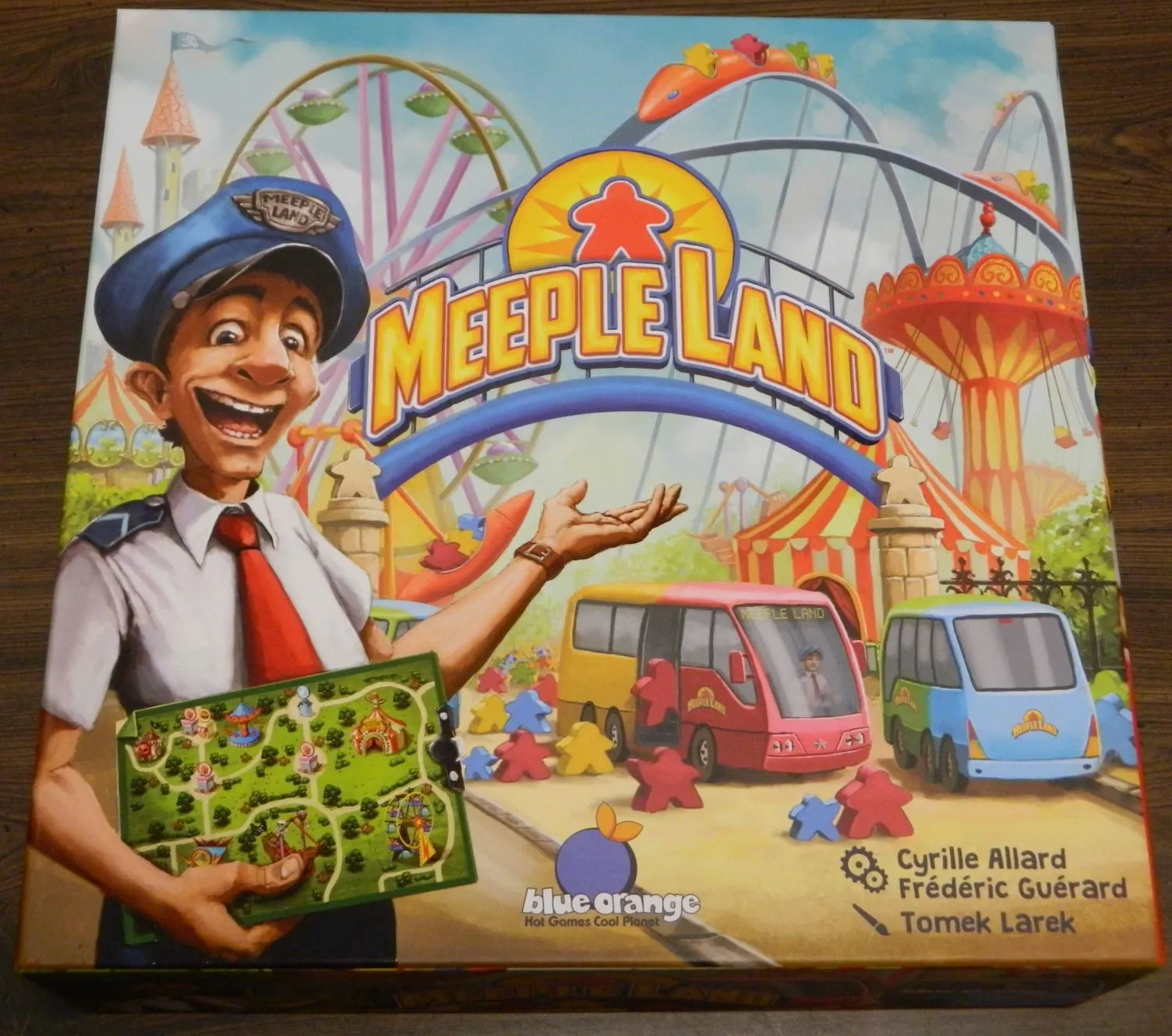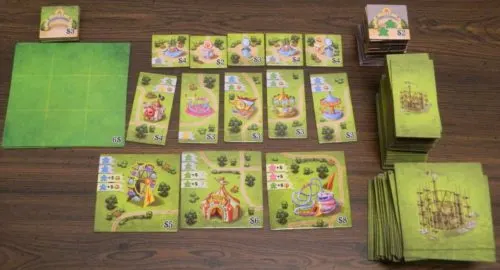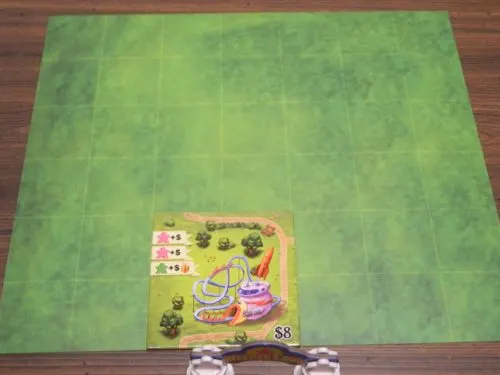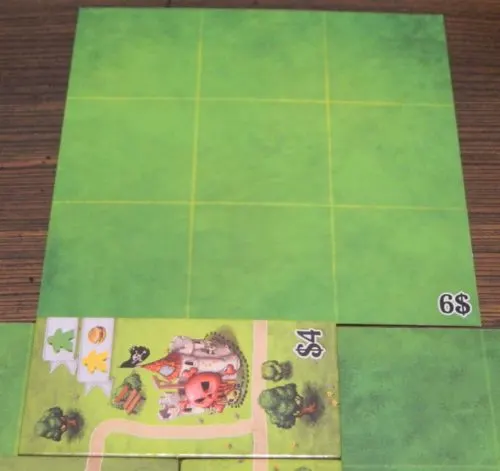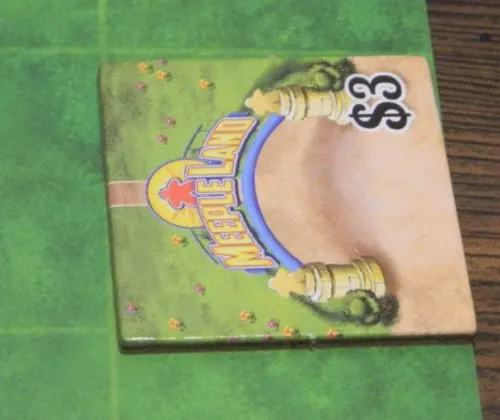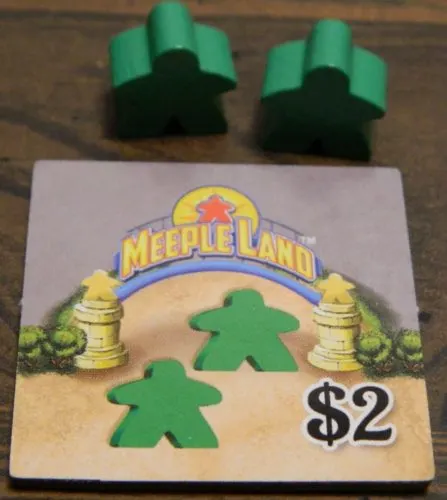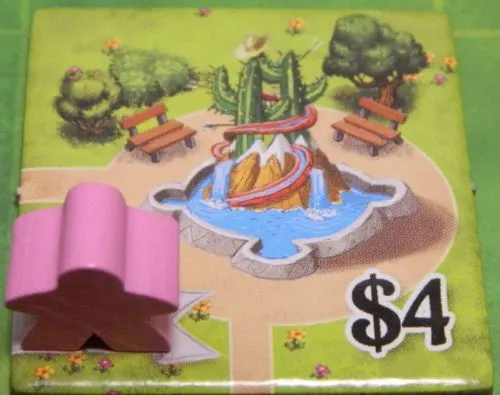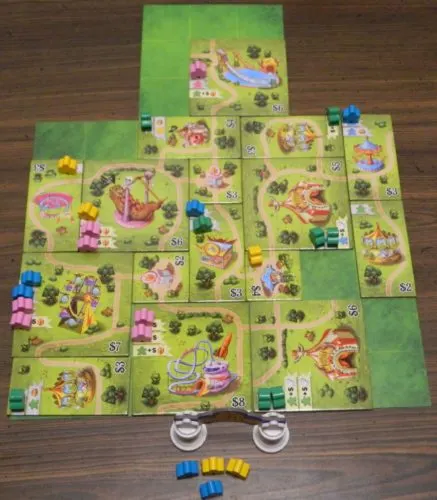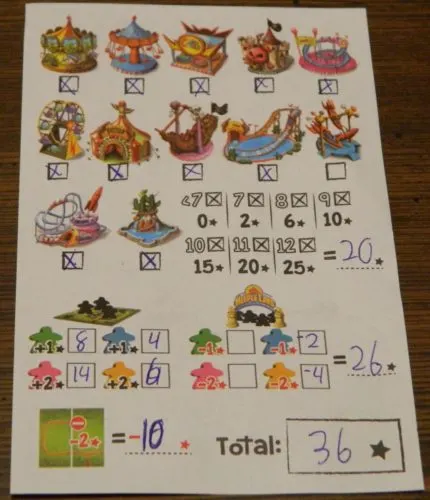While I haven’t been to an amusement park for quite a while, I have always liked them. Growing up I was a big fan of the Roller Coaster Tycoon series. I have always thought the amusement park theme would work well for board games as well. There have been a number of amusement park themed board games created over the years with Unfair and Steam Park probably be the most well known. In the past I have also checked out the Disney Magic Kingdom Game and the Roller Coaster Tycoon Board Game. While Steam Park is a really good game I was looking for a game that focused more on actually building a large park. This is why I was excited when Blue Orange Games sent me a copy of one of their newest games Meeple Land. In Meeple Land you and the rest of the players are in charge of making your own amusement park as you compete to build the park with the best reputation. At first glance Meeple Land might look like your typical tile laying game, but beneath the surface is a surprisingly deep and satisfying experience where you can build the park of your dreams.
How to Play Meeple Land
Setup
- Place the Parking Lot board in the middle of the table.
- Shuffle the Bus tiles together and create a face down draw pile. Take a number of Bus tiles as there are players +1 and place them face up on the Parking Lot board. Place the corresponding Visitor Meeples on top of each Bus tile.
- Place the Round Marker on top of the one space on the Parking Lot board.
- Sort the Attraction/Service tokens by their size. Find the Extra Entrance tiles (1 x 1 tiles) and set them aside. Shuffle the groups of tiles and place them face down into their own piles. Take the top five tiles from the small (1 x 1) and medium (2 x 1) piles and place them face up on the table. Place the top three tiles from the large (2 x 2) pile and turn them face up as well.
- Place the four Plot Extensions, Visitor Meeples, and Coins on the table where everyone can reach them.
- Each player will take the following:
- One Plot board
- One Park Entrance (comprised of 2 pillars and a banner). This will be placed in front of the small path on their Plot Board.
- One Scorecard
- Writing Utensil
- The last player to visit an amusement park will take the Park Ticket token which indicates that they will be the first player.
- Each player will take money at the beginning of the game based on turn order:
- 1st player: $0
- 2nd player: $1
- 3rd player: $2
- 4th player: $3
Playing the Game
Meeple Land is played over four rounds. Each round will consist of a number of turns. To begin each round all of the players will take money corresponding to the amount listed on the Round Tracker on the Parking Lot Board ($15 – first round, $10 – second round, $5 – third round, $0 – fourth round).
Players will take turns (in a clockwise direction) choosing one of three actions: Buy A Tile, Advertise, or Pass.
Buy A Tile
If you choose this action you can choose one of the face up tiles in the middle of the table to purchase. You can buy an attraction, a service, a Plot Extension, or a Park Entrance. To purchase the tile you will pay the price shown on the tile. If you purchased an attraction or service you will draw a new tile of the same size to replace the tile that was bought.
Once you purchase a tile you will have to place it in your Plot board. When placing tiles they must fit entirely within the grid system. Before placing a tile it can be rotated in any direction. The first tile you place in your park must connect to your entrance.
All other tiles must have one of their paths connect to a path already present in your park. Once a tile has been placed it cannot be turned or moved in any way until the end of the game.
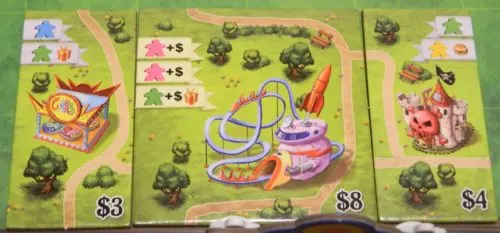
Pictured are three different tiles. The middle tile was the first tile added to the player’s park. The tile on the left could not be placed because it doesn’t connect to one of the paths already in the park. The tile on the right could be placed as one of the paths connect to the first tile that was placed.
While most of the tiles in the game are attractions, there are a number of services as well. These services provide their goods to each tile next to them that share a path with them. If a Service tile features two different services they will provide both to each attraction that they are connected to.
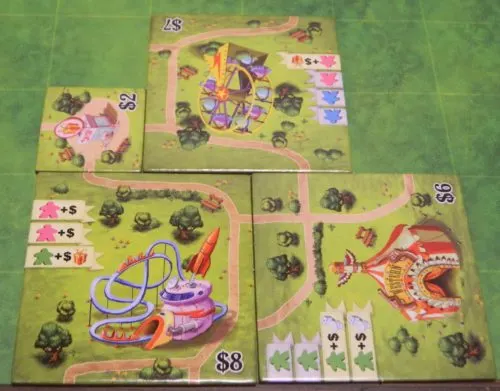
This player has placed a shop in their park. The shop will apply to the rocket ride as it shares a path with it. The shop won’t apply to the Ferris Wheel as they don’t share a path. The shop also won’t apply to the western show as it is not placed next to the tile.
Once during the game each player has the opportunity to purchase a Plot Extension for $6. You can place the extension on any side of your park as long as the grid matches up with your main plot. The only rule is that a Plot Extension cannot be placed if it blocks an entrance.
Players also have the option to purchase one additional entrance during the game for $3. The entrance can only be placed along the edge of your main plot or an extension.
Advertise
Instead of purchasing a tile a player can choose to purchase an advertisement. When purchasing an advertisement you will purchase the top face down tile in the small stack. By buying the advertisement you will receive visitors corresponding to the colors pictured on the tile. You will place the Visitor Meeples either at your entrance or at one of your attractions (see the Welcome Visitors section below). The advertisement tile that you bought will then be put at the bottom of its stack.
If there aren’t enough Visitor Meeples to give a player all that they are owed, they will still have to pay full price and only receive those that are still available. This also applies when trying to fill the buses at the end of a round.
Pass
If a player can’t or doesn’t want to buy a tile or advertisement they will have to pass their turn. Once a player passes their turn they will take no more actions for the rest of the round. By passing you will get to take the Bus tile that you want and all of the Meeple on it.
End of Round
Players will keep taking turns until all of the players have chosen the pass action and have taken one of the buses. Once a round has ended players will take four actions.
Welcome Visitors
Add the Meeples from your Bus tile to your Park Entrance and discard the Bus tile to the box. Each player can then move the visitors from their entrance into their park.
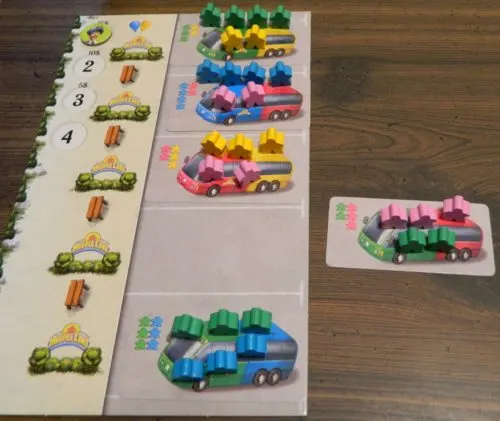
This player has chosen to take the Bus Tile which features three pink and two green visitors. They will place these visitors in their park.
Each attraction that you place in your park will have a number of banners along the left side. For each of these banners you can place one visitor of the corresponding color on it.
If one of the banners shows one of the service icons you can only place a visitor on that spot if the corresponding Service tile is connected to the attraction.
Fountains are wilds and can take visitors of any color.
Any visitors that don’t have a space available to them in your park will be left at your entrance.
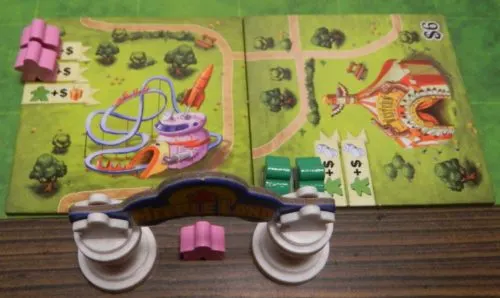
This player has placed some of their visitors into their park. The green visitors couldn’t be placed on the bottom spaces of either tile as the corresponding services are not connected to them. As there is no space for the third pink visitor they will stay at the entrance until they have an attraction to move to.
At any time during the game you have the ability to move visitors around your park including during other players’ turns.
Receive Revenue
After everyone has placed their visitors each player will receive money for each visitor in their park (not including those at the entrance). You will receive $1 for each visitor at an attraction. Any special spaces with a +$ symbol that have a visitor on them will earn you another $1.
Each player will take money from the bank corresponding to their total.
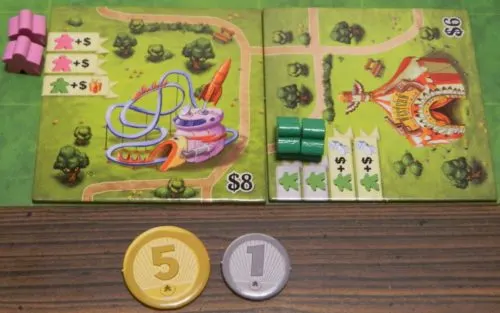
This player has added four visitors to their park. They will earn $4 from those guests. They will earn an additional $2 because the pink visitors where placed on spaces with +$.
Determine First Player
Each player will count up their money. The player with the least money will become the first player. They will take the Park Ticket to indicate that they are the first player. If there is a tie the tied player closest to the current first player (in a clockwise direction) becomes the first player. If there is a tie the current first player cannot be the first player in the next round.
Place New Buses
The Bus tile that is still in the Parking Lot will be moved to the top space. You will then draw a number of new Bus tiles so there is enough buses for each player plus one. You will place the corresponding visitors on each of the new buses.
The Round Tracker will be moved down one space. The next round will be played the same as the last round starting with giving players the starting cash for the round.
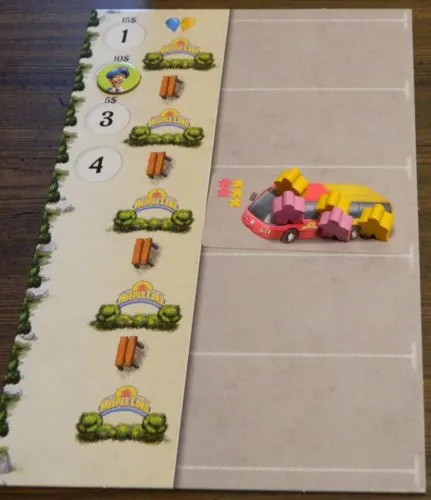
To start the next round the Bus tile still in the Parking Lot will be moved to the top space. The other four spaces will be filled with new Bus tiles.
End of Game
The game ends after the fourth round has been completed. Players will then tally up their reputation points from a couple different sources.
First players will count up the number of different attractions that they have in their park. Fountains count as an attraction but Services do not. You will score points for your attractions based on this chart.
- 7 different attractions – 2 points
- 8 different attractions – 6 points
- 9 different attractions – 10 points
- 10 different attractions – 15 points
- 11 different attractions – 20 points
- 12 different attractions – 25 points
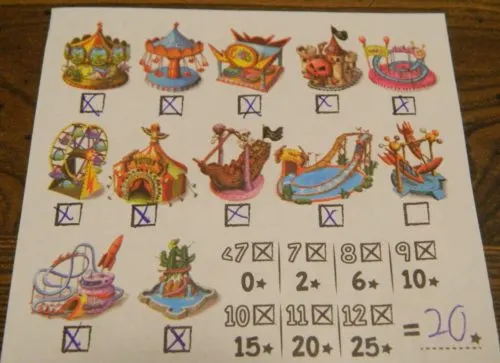
This player was able to place eleven different attractions into their park so they will score 20 points.
Players will then score points for the visitors in their park. Each player will score one point for each green and blue visitor in their park. They will receive two points for each pink and yellow visitor in their park.
If a player has any visitors left at their entrance they will lose points for them. For each green and blue visitor at an entrance players will lose one point. For each pink and yellow visitor players will lose two points.
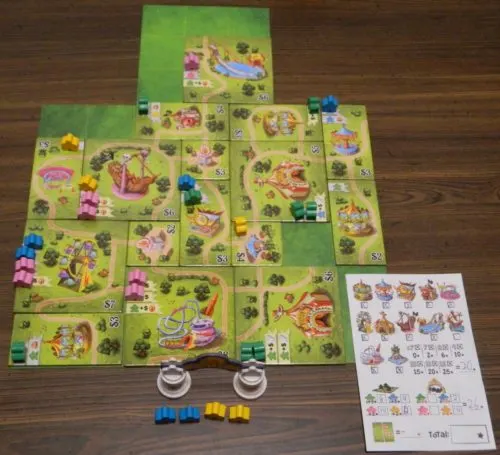
The player will score points from their visitors as follows: 8 green visitors – 8 points, 4 blue visitors – 4 points, 7 pink visitors – 14 points, 3 yellow visitors – 6 points. The player had four visitors left at the entrance though. They will score -2 points for the blue visitors and -4 points for the yellow visitors (2 * -2). They will score a total of 26 points for their visitors.
Finally players can lose points for the layout of their park. For each path in a player’s park that is cut off by another tile they will lose two points. Paths that extend out of a park or are not cut off by another tile won’t lose any points.
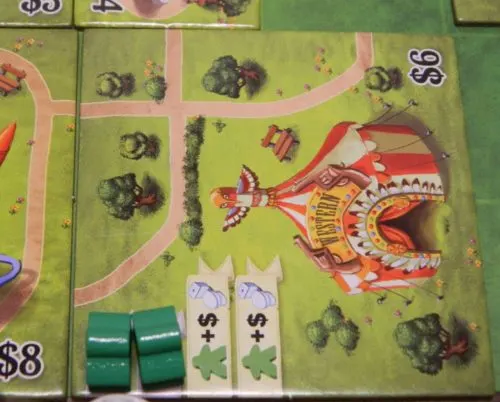
From this tile the player created two dead ends (bottom left and top left). They will lose four points from them. The path in the top right corner will not lose them points as it is not connected to another tile.
The player with the most total points wins the game. If there is a tie the tied player with the least negative points wins the game. If there is still a tie, the tied players share the victory.
My Thoughts on Meeple Land
Heading into playing Meeple Land I didn’t know exactly what to expect. The first thing that came to my mind was Steam Park. This was obviously due to the fact that the two games share the same theme and both involve placing Meeples on rides. That is basically where the similarities between the two games ends as Steam Park is mostly a dice game while Meeple Land fits firmly into the tile placement genre. While the themes are totally different, I actually found Meeple Land to be quite a bit closer to Kingdomino another game made by the same publisher. I will admit that the comparison is not perfect as there are a lot of ways that the two games differ, but I kept thinking about Kingdomino while playing Meeple Land. It just seems to have that same simple but satisfying gameplay that made Kingdomino really stand out.
At its core Meeple Land plays a lot like your typical tile placement game. The heart of the game involves buying attractions and services and placing them into your park in order to attract visitors. These visitors give you money which allow you to purchase additional tiles on future turns. The tile placement mechanics are pretty similar to a lot of games in the genre. Basically each tile in the game has a number of paths extending out of it. To place a tile you need to connect at least one of the paths to other tiles that you have already placed in your plot.
Placing tiles seems easy at first but there are actually quite a few things that you have to consider. If you just haphazardly place attractions in your park you are going to have troubles. First you only have so much space in your park. To do well in the game you need to utilize your space as well as possible. You can buy one park extension, but that only gives you nine extra spaces. To maximize your score you want to stuff as many attractions into it as you can as that will allow you to score more points as you can attract more visitors and score more points for the variety of attractions in your park. You need to have somewhat of a plan of how you are going to weave paths through your park or you will create a lot of spaces that you won’t be able to fit attractions into. Having a plan is also important as you don’t want to have paths that run into the grass of a neighboring tile as that will lose you points.
When choosing which tiles to purchase you have a number of different things that you need to consider. First whenever possible you are probably better off purchasing attractions that you don’t already have in your park. There is no penalty for having duplicate attractions, but each additional type of attraction that you have in the park will score you more points at the end of the game. You can score a lot of points if you can get most if not all of the different types of attractions into your park. Second while they don’t directly score you points you need to consider purchasing services. Services are really interesting as they open up additional visitor slots on the adjacent attractions that show the same symbol. This allows you to earn more money at the end of each round as well as score more points. Finally you need to purchase attractions that will attract the visitors that you already have in your park as well as visitors you plan to receive at the end of future rounds.
While tile placement is the main mechanic in Meeple Land, managing your current visitors and future visitors is key to your success in the game. You can score a lot of points as well as lose a lot of points from visitors. Basically you want to build a park that works for the visitors that come to your park. At the end of each round you will acquire between five to seven visitors from the Bus tile that you choose to take. You can also choose to advertise which will give you two visitors. The main objective of the game is to build attractions that will attract the Meeple colors that you receive throughout the game. You have some control over what visitors you get, but you usually won’t have full control over who shows up. Therefore your strategy needs to be open to adjustments in case you get stuck with a bunch of visitors that you don’t currently have room for. Being able to place the Meeples on attractions is key for two reasons. First you will receive money for each placed Meeple at the end of every round which is how you expand your park. Each placed Meeple will also score you points at the end of the game.
Outside of losing out on money and points for not placing Meeples, it is key to place them as you will lose a lot of points if you have a lot of visitors stuck at your entrance. For each Meeple that you don’t place you will lose one or two points. This can really add up so you need to keep the current visitors at your entrance as well as the visitors you will get at the end of the round in mind when you purchase attractions during the round. The key to doing well in the game is matching your park to the customer demand. Leaving empty spaces on your attractions limits how much money you can make which will really slow down your expansion.
When I first started playing the game I honestly didn’t think the Bus tiles would play a large role in the game. I thought it would be easy to fit all of the visitors in your park so it wouldn’t really matter which bus you ended up with. I was sadly mistaken as this decision can be really costly if you make the wrong decision. At the beginning of the game I honestly thought the best strategy was to spend all of your money each round as it would give you more locations to place visitors which would earn you more money for the next round. I can see the value in passing early though solely due to getting the bus that you really want. If you wait too long you could easily get stuck with a bunch of visitors that you can’t place in your park. This leaves money on the table and forces you to build attractions on future turns to try and find a place for them.
I found this to be an interesting mechanic as you really have to manage your visitors in order to do well in the game. It also adds some luck to the game though which I am not a huge fan of. A lot of times it will be your fault if you get stuck with a lot of unwanted visitors as you waited too long to act. There are some times where you have no options though. You may just have one or maybe no buses that you can really use. You can somewhat plan ahead for the current round by purchasing attractions that hold the visitors that you plan on acquiring. There is no way of knowing what buses will show up on future rounds though. You could end up building a lot of attractions that require visitor colors that you can’t get. In addition to the buses there is also some luck in getting tiles that you need to show up in the market. You likely aren’t going to win just by having good luck, but luck could be the difference between winning or losing in a close game.
While the game relies on a decent amount of luck at times, your strategy is going to play a much bigger role in how well you do. On your turn you only have a choice between three different actions, but that still presents you with quite a few different options. Between the number of different tiles that you can purchase to managing your visitors and whether you should advertise, you have a lot of things to consider before choosing your action. Then when you purchase a tile you have to choose how you will place it. There will be a few times where you might not want to take any of the actions, but it is much more likely that there will be several different actions that you will want to take. Most of the time I think the player that implements the best strategy will win the game. The game has a number of different strategies to pursue which I think will help the game last.
With how much strategy Meeple Land has I was actually a little surprised that it was considerably easier to play than I was expecting. The game has a recommended age of 10+ which seems about right. Meeple Land is clearly more complicated than your typical mainstream game, but it is still surprisingly easy to play. This is because you only have three options to choose from and the scoring is quite simple as well. It may take a couple of turns to truly grasp all of the mechanics, but it will then move pretty smoothly.
For its simplicity Meeple Land takes a little longer than you would expect. The game has an estimated length of an hour and that seems about right. Your first game or so may take even a little longer. The more you play the game though I think you can shed some time as players become more familiar with the mechanics. I think the main reason why the game takes longer than you would initially think is the fact that the game sometimes encourages analysis paralysis. There will likely be times in the game for each player where they will have a lot of different options to consider where if they make wrong decision they will likely lose quite a few points. Therefore these turns could take quite a bit of time. On a lot of turns most players should be able to finish their turn pretty quickly, but each player will likely have a couple of turns like this where the other players will have to sit around waiting for them.
As for the components I was actually quite impressed especially with the game retailing for $35. Looking at the number and quantity of components I honestly would have expected the game to retail for $40-60. Meeple Land has a lot of components as there are plenty of tiles where you will never go through all of them within one game. Most of the components are made of cardboard which is pretty thick. I thought the game’s artwork was great. As you build your park it really looks like you are making an amusement park. The tiny little Meeples are also really cool. I really only had one issue with the components. The problem is that there appears to be a typo on the Plot Extension tiles. All of the other components in the game have the dollar sign appear before the number, but on the Plot Extension tiles the opposite is used. This creates a problem for the game as it honestly looks like the Plot Extensions cost $9 instead of $6 as there is no obvious top to the tiles. We ended up playing the first game with these tiles being $9 because we never referred back to the rules. As I received a pre-release copy I don’t know if this will be fixed for the final release of the game. Its not a big deal though once you know the tiles are $6.
Should You Buy Meeple Land?
While playing Meeple Land I have to say that it is the closest that I have ever seen a board game get to recreating video games like the Roller Coaster Tycoon series. The mechanics are obviously different as the game is a tile laying game, but the overall feeling of building your park is very similar. Meeple Land is built around its tile placement mechanics as you need to buy and add attractions to your park so there is a path that connects all of them. You need to be careful when building your park as you otherwise will quickly run out of space and lose points at the end of the game. At the same time you need to manage the visitors that arrive at your park as you need to build attractions for them in order to earn money and points at the end of the game. There is some reliance on luck in the game, but strategy usually plays a bigger role. The game is easier to play than it first appears as it finds a good balance between accessibility and simplicity. There are some moments where analysis paralysis can drag down the game though. The game is topped off by components that are a lot better then you would expect for a game that retails for $35.
My recommendation for Meeple Land is simple. If you don’t like tile placement games or don’t care for the amusement park theme, it probably won’t be for you. If you have any interest in the genre and theme though I think you will really enjoy Meeple Land and should consider picking it up.
Buy Meeple Land online: Amazon, Blue Orange Games
We would like to thank Blue Orange Games for the review copy of Meeple Land used for this review. Other than receiving the review copy we at Geeky Hobbies received no other compensation. Receiving the review copy had no impact on the content of this review or the final score.

